It had been more than a year since a fox took one of our hens. But on this summer day it decided to pay us a return visit. I could hear the mayhem from my desk and by the time I got outside, my sweet rooster, Cilantro, was being carried up the hill and out of my sight. It happened in a flash — our doors were open, we were all here. The fox didn’t seem to care. We also lost a black maran that day. The lovely Lucy Parsons— named (very ironically) after an anarchist feminist—was taken in the quiet shade of a lilac bush not more than ten feet from our deck — where the pile of black feathers still reflected some blue and green in the glint of the late afternoon sun. But losing Cilantro, one of two cochin roosters hatched by my broody hen, winded me: his tangerine comb, his little sideways glance as he’d walk past me, how he would take grapes so gently from my hand, and his unbelievably comical, feathered feet.
Having kept chickens now for over a decade, there are enough stories to fill a book. Like when Emma Goldman hatched four little Icelandic chicks during hurricane Dorian, or when two sibling hens, Rosie and Annapurna went broody at the same time and hatched out three chicks between them and then co-parented them. Or the time when Dill, from Emma’s first brood, was showing signs of being eggbound and I brought her in the house, put her in some warm water, and she promptly laid the egg. Or that horrible day when Mr. Dorian was killed by a hawk. Or when Lorca rejected her newly hatched chick—nearly killing it—and I had to raise the little rooster by hand in our bath-tub for 6 weeks. Or how I tended to Big Comb in her final days by giving her special treats, and moving her silky body into the sunshine. Near the end of her life she still made a little sound of recognition when she saw me.
Cilantro (centre), dill (left), basil (right).
Dill drying off by the woodstove with some oatmeal after being eggbound.
A very broody Emma Goldman finally becomes a mama of 3 cochin chicks, Basil, Cilantro, and Dill.
In his 2020 book, Pastoral Song: A Farmer’s Journey, James Rebanks refers to these as “backstories,” and anyone who has raised chickens, or any farm animals on a smaller scale, knows each animal’s life history and recognizes their unique personality. At one time, having this connection to farm animals was all part of being a farmer.
Rebanks is a shepherd in the Lake District in northwestern England, and his beautifully written book is remarkable for its ability to show, through the stories of his grandfather and father—both farmers as well—how farming, and farmers, have changed over time: how what his grandfather valued, and how he lived, has nearly disappeared.
Rebanks describes the transition as a “great simplification” that came with “its own morality and ethics.”
Small farms that had diverse crops and animals were replaced with specialized ones where animals—which once all had “characters” and “backstories” became “units of production,” and were no longer an integral part of the farm, or the fertility cycle. He describes how his own father, who was “no animal rights activist,” would let his cows spend the summers in the fields. But not so for the new farming. On the big modernized dairy farms, the cows were never let out in the fields. The “logistics” of 200 cows going outside “became problematic,” he writes.
I’ve struggled with the idea of raising farm animals ever since I read the 1977 classic Living the Good Life, by Helen and Scott Nearing. I came across the book in the early 1990s, when we were trying our hand at growing some food on some land in northern Quebec, though on a small scale. We had a menagerie of animals at the time—a horse, some goats, a couple sheep—but none that produced anything, except manure and work, of course! They were basically pets. The Nearings refused to raise animals, or eat any meat, because they didn’t want to contribute in any way to their exploitation, and I totally get that. But for me, “having” animals has always helped ground me. Same with the chores around having them. They bring a rhythm to my day. Creatures need tending. I feel like my life without animal companions would be more scattered and certainly more sedentary.
I also like having a hand in the food I eat (in this case, the eggs), and trying to do that in a way that honours a chicken’s sentience.
Big Comb free ranging in the garden.
Rebanks says his grandfather referred to his way of life as “living quietly,” where they wore old clothes and only shopped occasionally for the essentials they couldn’t grow. Rebanks says his grandfather knew he was choosing freedom: “If you didn’t need things — shop-bought possessions— then you were free from the need to earn the money to pay for them.”
The people caught up in the “new farming” had to “change [their morality and ethics] or get out, and things that initially shocked them soon became the new normal.”
Animals could be kept healthy with antibiotics in crowded, industrially scalable conditions that would once have made them ill. Antibiotics were, of course, used to cure individual sick animals; but more worryingly they began to be administered to large groups of animals to prevent illness and, surprisingly, to promote growth. In 1950, scientists in New York had discovered that by adding tiny traces of antibiotics to animal feed they could increase the growth rates of animals. Thereafter antibiotics were routinely also used in animal feed, particularly in the most intensive American systems, for cattle, chickens, and pigs, to improve feed conversion.
Behind the antibiotics and vaccines came a whole host of other medical products, such as anthelmintic wormers used as drenches, squeezed down the throat to expel internal parasites, pesticides to kill external parasites like lice, hormones to make animals grow quicker, organophosphate dips for sheep to kill wool and skin parasites. With these tools, farmers could now concentrate animals in confined areas on a scale that had never before been possible. Farms were becoming machines. It was farming by numbers, as designed by accountants.
In truth, apart from the joy I’ve experienced watching and caring for chickens, keeping a small flock over the years has also been an act of resistance against the inhumane treatment of farm animals and the unsustainability of it all.
In his 2009 book, The Gift of Good Land, Wendell Berry writes that “Our dilemma in agriculture now is that the industrial methods that have so spectacularly solved some of the problems of food production have been accompanied by ‘side effects’ so damaging as to threaten the survival of farming.”
Berry writes:
My immediate concern here is with the irony of agricultural methods that destroy, first, the health of the soil and, finally, the health of human communities… This is the kind of surprise that is characteristic of our time: the cure proves incurable… It is only when it is understood that our agriculture dilemma is characteristic not of our agriculture but our time that we can begin to understand why these surprises happen, and to work out standards of judgment that may prevent them.
Here on this land—mostly rocks and thin forest soils—buffeted by salty winds from the ocean, vegetable gardening has been a challenge to say the least. The chickens help with the soil building — returning much more to the land than they are taking. Farmers have intuitively always known that adding organic matter improves soil health. But the industrial system of food production has forced them in a different direction.
Battery farmed eggs. Wikimedia commons.
Rebanks describes how the “new farming” took what was a kind of symbiosis—grazing animals and fertilizing fields—and “separated them to create two massive industrial-scale problems in separate places.”
“The farms with thousands of animals had much more than their land could possibly accommodate, while the crop farms now had no animals, and thus no muck to fertilize plants, so were entirely reliant on Haber-Bosch fertilizers. Livestock in the new system were now creating manure so acidic that the soil it was spread on began to compact and die. Crop-growing farms were top-dressing with ammonium nitrate and killing their soil. Everywhere, on both sides of this insane division, the unseen living things in the soil (billions in every teaspoon of healthy soil) that had once made it all work were being killed off.”
“It was like a kind of arms race with the large modern farms trying to swallow up the little old-fashioned ones like ours.”
Rebanks writes:
The new technologies and ways of using them unraveled our farm like someone pulling at a loose thread on an old jumper. First the horses disappeared. The pigs vanished next. Then the small flocks of turkeys and hens went. As pieces of the farm were taken away there were all kinds of knock-on effects. When the horses were sold our need for fields of oats went too. When the dairy cattle went, the milk stands grew nettles and the butter churns, paddles, and molds were stashed on a dusty shelf in the pantry. We no longer grew fields of turnips or barley. Instead, we bought cheap sheep feed from a local mill made from imported American lupins, maize, or palm kernels. All the fields on Dad’s rented farm were soon a single shade of green.
Rebanks explains that the “economics of farming made it virtually impossible to opt out.”
He says pausing wasn’t an option, unless you wanted to go bankrupt or end up in a downward “spiral of debt.” Globalization meant that prices were being “driven down by the vast quantities of commodities being produced by the super-efficient new farming that dominated North America, which was spreading rapidly around the world.”
Rebanks recounts a road trip he took to the American Midwest—the heart of American farming country—where he saw the ruins of what were once small family farms. “America chose industrial farming,” he says, and the result was a “landscape and a community that was falling apart.”
He describes it as an “ecological disaster” where humans are hardly required anymore:
“What couldn’t be done by immigrant work was done by machines, which were now self-navigating, and able to do the work in the field guided by satellites. These farms could impose their will on the land as never before, and increasingly the ‘farmer’ didn’t even need to be there to do it.”
But even though there has been an incremental transformation over several decades in how food is produced, Burbank reminds us that with 2 billion farmers on the planet, the vast majority are still not highly mechanized.
About 80% of us are “still fed by small farmers,” he writes.
Finger millet harvest, Dungkarling, Bhutan. Finger millet, as well as buckwheat, mustard, and amaranthus, are traditional grains that are rarely grown anymore in Bhutan, but there is a move to re-introduce them. Photo: Linda Pannozzo
For nine months in 2010-2011, my husband, daughter and I lived in Bhutan – first in Dewathang, and later in Thimphu, where I worked as a senior researcher for a Halifax-based NGO. My task was to find out why local farmers were finding it so hard to achieve food security. By interviewing farmers (with the help of a translator) we found that food security did not exist in the highly agricultural country.
For instance, shop-keepers, farmers, and villagers all told me that the vegetables in Dewathang—the village we lived in for 5 months—were all bought in Samdrup Jongkhar, about a half hour drive away on the Indian border, or at an even lesser cost directly from market vendors in Darranga, India, and then resold in Dewathang at a slightly marked up price. To save some money, most villagers opted to go to Samdrup Jongkhar or into India themselves for their groceries. The mystery about why there wasn’t more local, Bhutanese produce being sold isn’t actually that much of a mystery: there was so much rain in the summer that growing vegetables was very difficult, and in the warm but dry winter season when things grow well, there was little access to water.
But there was another reason—local produce just couldn’t compete.
Most of the food the Bhutanese would buy in Darranga – not unlike the food that we find in the produce sections of our grocery stores —is grown in industrial, highly mechanized, chemical-laden farms located on the Assam plains, where it’s farmed by impoverished Assamese labourers paid rock bottom wages. And if it’s not grown in Assam, the cheap, chemically grown produce is shipped in to Guwahati from other parts of India by the truck load, and then to Darranga, a stone’s throw from the Bhutan border.
No matter where the food is being grown in the world, one thing is for sure: everyone is looking for cheap food.
According to Bill McKibbon, in his 2008 book Deep Economy: The Wealth of Communities and the Durable Future, there are essentially three reasons why food is cheap: first, the real costs of growing it have been externalized; oil is still relatively cheap; and industrial chemical farms are highly subsidized. Cheap food comes with real costs—the loss of local family farms means loss of farm communities and lots of displaced farmers; there are health costs associated with using pesticides and eating food laden with pesticide residues; there are costs associated with cruelty to animals in factory farms; and there are enormous environmental costs, including soil loss, degradation, and erosion, and water pollution, to name just a few. If these very real costs were included in the price of imported food we currently get in the grocery store, no one would be able to afford it.
Farmer tending to rice paddies, Thimphu, Bhutan. Photo: Linda Pannozzo
I met Vandana Shiva when I was in Bhutan because the project I was involved in had brought her and the farmer trainers from Navdanya to Bhutan to assist the local farmers in organic methods and techniques. I’ll never forget how Shiva chastised one of the Bhutanese farmers for calling the pesticides he was spraying on his mango trees “medicine.” You could hardly blame him, since government documents refer to pesticides as “plant protection chemicals.” Shiva corrected him saying, “These aren’t medicines, they’re poisons.”
Shiva says the most productive form of agriculture is not the modern tractor-serviced, big field monocultures, but multiple-crop, manual-labour-intensive smallholdings. She says when farms get bigger, overall productivity drops.
Agricultural productivity is conventionally defined in terms of the yield from a single crop. Thus, companies like Monsanto, a former agrochemical and agricultural biotechnology company (purchased by Bayer in 2018), and their agriculture “experts” typically touted the short-term gains from particular “high-yield varieties” of corn, maize, rice, or other single crops. These uniform, genetically engineered seeds have largely replaced the diverse farmer-saved seeds of previous generations. Based on this narrow definition of agricultural productivity based on single crop yield, a myth has arisen that industrial, chemical-based monoculture systems are more productive than small organic diverse systems.
“Biodiverse mixed farms have more food production per acre, more nutrition per acre, and more health per acre,” says Shiva. Monoculture farms might have more maize, or whatever particular crop is being grown, but much less food per acre in total than diverse farms growing a wide range of crops.
“While these reductionist categories of yield and productivity allow a higher measurement of yields, they [also] exclude the measurement of the ecological destruction that affects future yields. They also exclude the perception of how the two systems differ dramatically in terms of inputs,” she says.
For example, with indigenous cropping systems, which are mixed, biodiverse, and organic, all the inputs come from the farm itself and are therefore cost-free to the farmer: seeds are saved from the previous season, soil fertility comes from compost and farm-yard manure, and pest control is natural and built into the cropping mixtures, says Shiva.
By contrast, monoculture systems yields are tied to the purchase of inputs: high yield variety seeds, chemical fertilizers and pesticides, petroleum, machinery, and irrigation systems.
“High yields are not intrinsic to the seeds,” writes Shiva, “but are a function of the availability of required inputs, which in turn have ecologically destructive impacts” and are expensive to farmers.
Vandana Shiva. Source: The Seeds of Vandana Shiva
Globalizing the market has effectively transferred control of farming away from the farmer, and into the hands of those who can shape that market, according to Raj Patel, author of the 2007 book Stuffed and Starved. The Hidden Battle for the World’s Food System.
According to Patel, power in the food system is held in only a few hands. He uses an hourglass figure to illustrate this: At one wide end there is a “superabundance” of farmers and producers, and at the other wide end are the mass of consumers willing to buy the produce, but the “bottleneck” happens in the distribution chain:
We’ve ended up at a world with a few corporate buyers and sellers. The process of shipping, processing and trucking food across distances demands a great deal of capital – you need to be rich to play this game. It is also a game that has economies of scale. This means that the bigger a company is, and the more transport and logistics it does, the cheaper it is for the company to be in the business. There are, after all, no mom-and-pop international food distribution companies. The small fish have been devoured by the Leviathans of distribution and supply. And when the number of companies controlling the gateways from farmers to consumers is small, this gives them market power over the people who grow the food and the people who eat it.
For example, take a coffee grower in Uganda. They might typically sell their beans for 14 cents/kg to a middleman who turns around and sells it to a mill for 19 cents. By the time the coffee is processed (de-hulled), bagged, and transported, it goes for 26 cents/kg. The exporter isn’t making the big profits either – usually only one cent per kilogram. By the time it lands in West London, where Nestle has a large coffee-processing/ roasting facility, it will cost $1.64/kg.
“Already at the gate of the Nestle factory, the cost per bag is well over ten times what the farmers received for it. But here comes the big jump. By the time the coffee rolls out of the other side [of the Nestle factory], the price is US$26.40/kg, or nearly 200 times the cost of a kilogram in Uganda,” writes Patel.
We also need to be reminded of Patel’s hour-glass metaphor when we think of global food crises. He cites the work of world renowned economist and philosopher Amartya Sen, who has observed that modern famines are not related so much to the absence of food as to the inability to buy it. During so-called food shortages, which often result in famines, there is often lots of food around, says Sen. “Those who have it hoard it, knowing that less food means higher food prices.” In other words, the bottleneck—how food is distributed—is the problem. Patel concludes: “The hour-glass shape of the food system is almost certain to deliver not food, but hunger.”
My small act of resistance includes 5 garden beds, two greenhouses, and a few chickens.
I know it’s not much—my small garden, built over rocks in a sunny clearing in the forest—but it’s my way of taking back some power over food, and being a good steward and honouring the natural processes.
But ultimately, it’s an act of resistance against the death machine that is the agri-food industry.
According to Rebank, “one of the best ways to create a better rural landscape is to mobilize the farmers, and other country people, working with what is left of their old culture of stewardship, and tapping into their love and pride in their land.”
Rebank says that he too is changing his farm in “lots of little ways:”
“[We are] creating new habitats by our becks, restoring bogs and grazing pastures in ways that will encourage a wider array of flowers, restoring meadows by bringing back seeds and plants of species we lost in the past century, and planting more woodland and hedgerows. I have come to care about… moths, worms, dung beetles, bats, flies, and the wriggling life beneath the rocks in our streams.”
Me too. In a world that seems to be going to hell in a hand basket, it’s something I can do that is life-affirming and helps me to feel connected and sane.

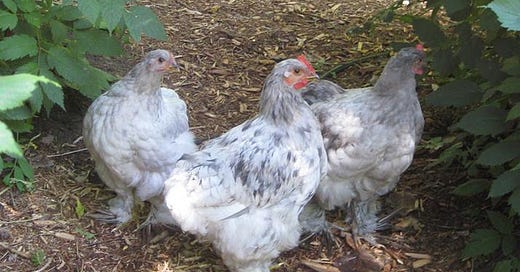



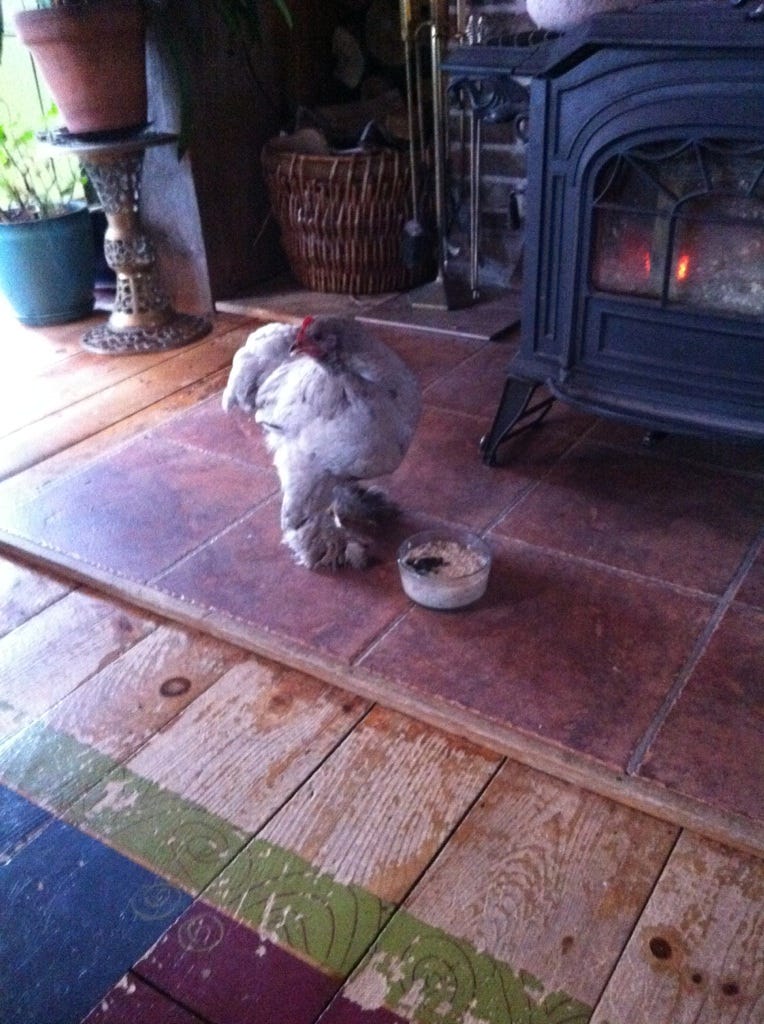
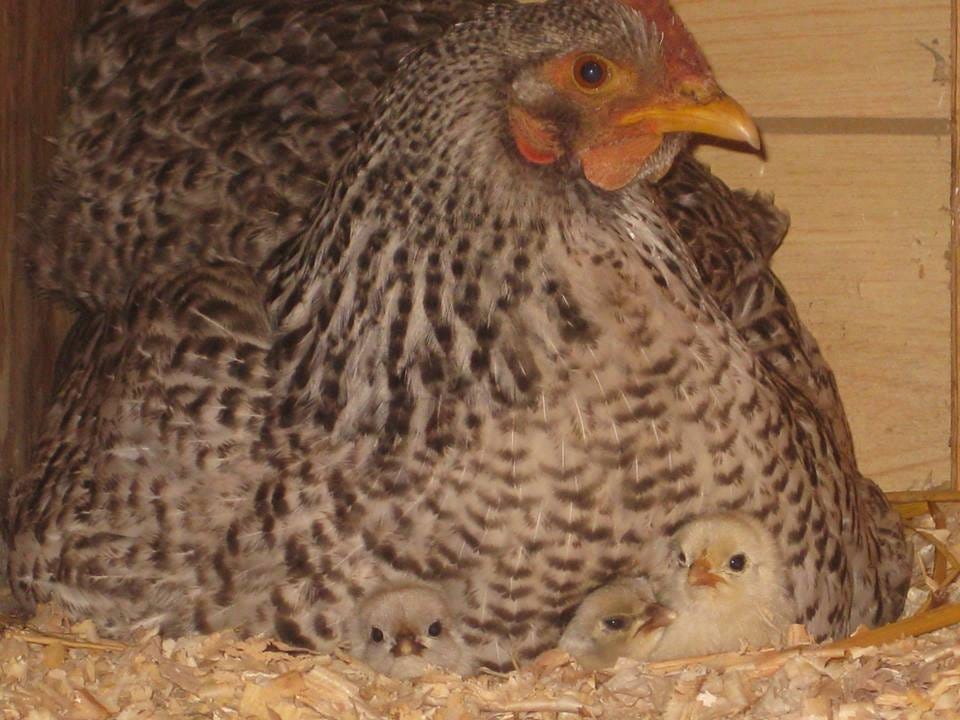
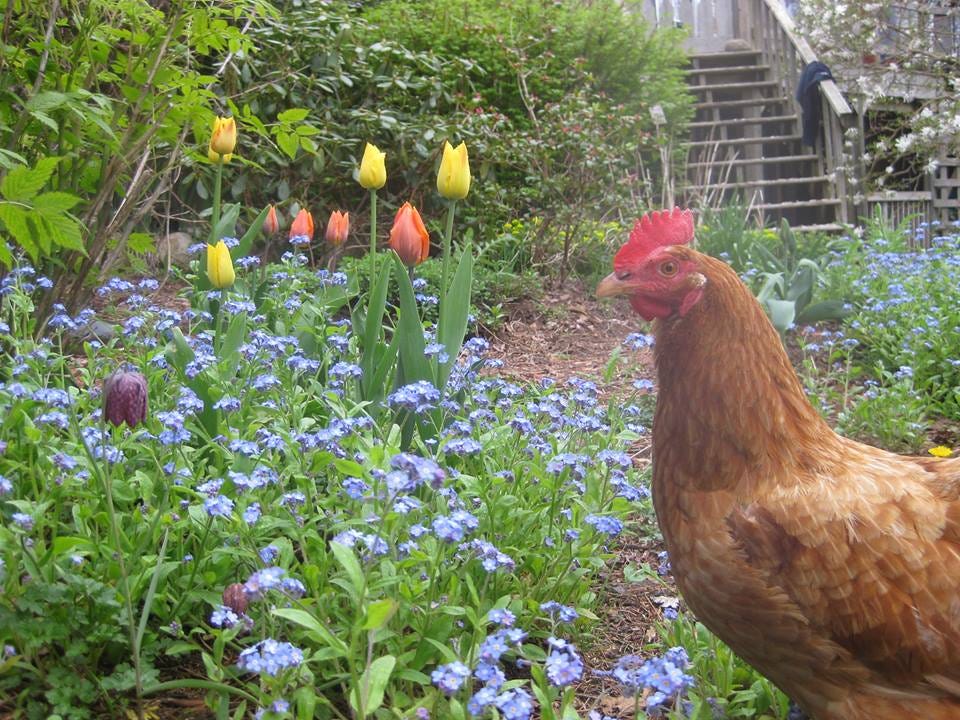
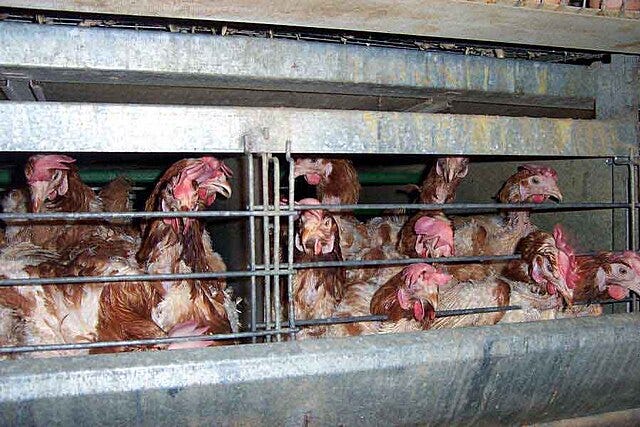

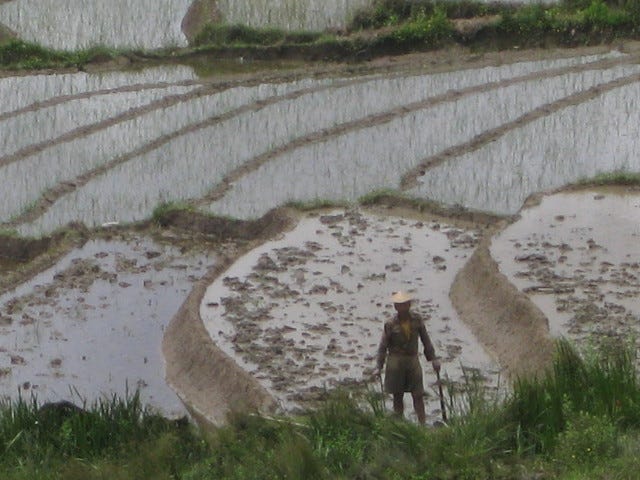

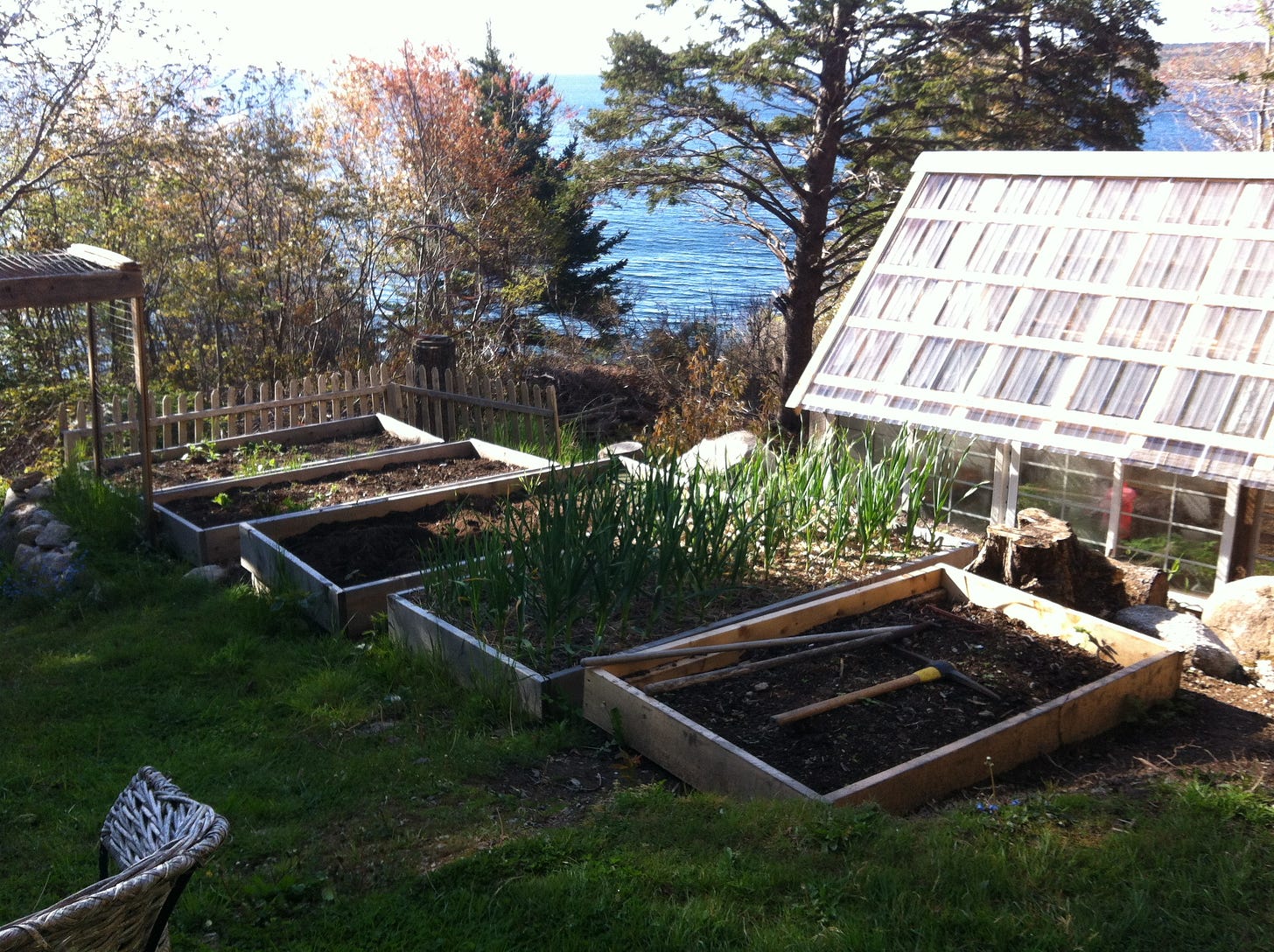
I thrive on small acts of resistance and am delighted to read about other people doing it. Love the chicken stories...albiet sad but recognizing the connections we can have with creatures if we pay attention. Thanks for this great article.
I think that 'story' is such an important tool for teaching and remembering. Thank you Linda for sharing the stories of these amazing chickens.
Like you I have many animal stories from the many years of keeping chickens and ducks and geese and turkeys etc.... And while many of these beings became food, they all got to experience joy, and curiosity, and taste diverse foods, and feel sunshine and rain...and sleep on roosts or live in family flocks. Even some of the 'industrial' creatures...such as the 'meat kings' I raised for a couple of years, even they got a chance to dig deep into their animal core and learn to act like chickens.
While raising animals for my family's food always comes with that moment of deep anguish when they are killed, I actually believe that if we considered all sentient beings with the same depth of feeling, perhaps we industrialized humans would get to dig deep into our cores, our long-forgotten stories, our teachings, and remember that all the animals, and plants welcomed us here and made covenant with us to offer their lives so that we could live. And our obligation in this covenant is...well...it's obvious really. It's to offer thanks and show respect.